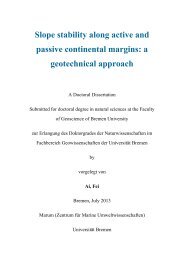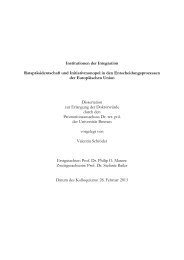Seismoacoustic Study of the Shallow Gas Transport and ... - E-LIB
Seismoacoustic Study of the Shallow Gas Transport and ... - E-LIB
Seismoacoustic Study of the Shallow Gas Transport and ... - E-LIB
You also want an ePaper? Increase the reach of your titles
YUMPU automatically turns print PDFs into web optimized ePapers that Google loves.
Outline <strong>of</strong> <strong>the</strong> Dissertation<br />
Outline <strong>of</strong> <strong>the</strong> Dissertation<br />
The dissertation is comprised <strong>of</strong> five chapters. Chapter 1 is an introduction to <strong>the</strong><br />
background knowledge <strong>of</strong> <strong>the</strong> dissertation about: <strong>the</strong> importance <strong>and</strong> different seabed<br />
features <strong>of</strong> <strong>the</strong> seabed fluid seepage related to <strong>the</strong> hydrocarbons; an overview <strong>of</strong> gas<br />
hydrates; <strong>the</strong> objectives <strong>of</strong> this study; <strong>the</strong> geological setting <strong>of</strong> <strong>the</strong> two study areas<br />
selected in <strong>the</strong> Black Sea; <strong>the</strong> method <strong>and</strong> datasets used in this PhD research work. After<br />
Chapter 1, three manuscripts (Chapters 2, 3 <strong>and</strong> 4) summarize <strong>the</strong> outcomes <strong>of</strong> <strong>the</strong> study.<br />
Chapter 2 discusses <strong>the</strong> gas migration <strong>and</strong> gas reservoirs related to mud volcanoes in <strong>the</strong><br />
central Black Sea, <strong>and</strong> <strong>the</strong> possible trigger factors <strong>of</strong> mud volcanoes eruptions. Chapter 3<br />
focuses on <strong>the</strong> research <strong>of</strong> <strong>the</strong> sedimentary processes <strong>and</strong> tectonic movements <strong>of</strong> <strong>the</strong><br />
Kerch Peninsula margin. In Chapter 4, <strong>the</strong> distribution <strong>and</strong> formation <strong>of</strong> <strong>the</strong> gas seeps<br />
area was studied, toge<strong>the</strong>r with <strong>the</strong> role <strong>of</strong> gas hydrates, sedimentary processes <strong>and</strong><br />
tectonic movements, especially <strong>the</strong> anomalous situation - Kerch seep area. The<br />
conclusion <strong>of</strong> <strong>the</strong> dissertation <strong>and</strong> an outlook are presented in Chapter 5.<br />
Chapter 2. <strong>Shallow</strong> <strong>Gas</strong> <strong>Transport</strong> <strong>and</strong> Reservoirs in <strong>the</strong> Vicinity <strong>of</strong> Deeply Rooted<br />
Mud Volcanoes in <strong>the</strong> Central Black Sea<br />
In Chapter 2, a set <strong>of</strong> 2D high-resolution seismic pr<strong>of</strong>iles is presented across six large<br />
mud volcanoes. Acoustic anomalies <strong>and</strong> near-surface sediment structures <strong>of</strong> deeply<br />
rooted mud volcanoes were studied based on <strong>the</strong> seismic dataset. Three types <strong>of</strong> <strong>the</strong><br />
gas/gas hydrate reservoirs <strong>and</strong> four types <strong>of</strong> pathways for gas/fluid migration are<br />
recognized. A clear “Bottom Simulating Reflection” (BSR) was identified in only one <strong>of</strong><br />
<strong>the</strong> seismic pr<strong>of</strong>iles. The formation history <strong>of</strong> <strong>the</strong> gas reservoirs was inferred, which were<br />
sealed by gas hydrates or fine-grained sediments. Six mud volcanoes reveal two to three<br />
major <strong>and</strong> concurrent eruption episodes. All <strong>the</strong>se eruptive episodes are probably related<br />
to distinct sea level falls, which seem to be one <strong>of</strong> <strong>the</strong> main trigger factors <strong>of</strong> <strong>the</strong> mud<br />
volcano eruptions in <strong>the</strong> central Black Sea. A structural model for <strong>the</strong> MSU mud volcano<br />
was presented with respect to mechanisms <strong>of</strong> gas migration <strong>and</strong> <strong>the</strong> origin <strong>of</strong> <strong>the</strong> gas.<br />
Chapter 3. Sedimentary Evolution <strong>of</strong> <strong>the</strong> Kerch Peninsula margin, Black Sea<br />
Chapter 3 presents a set <strong>of</strong> 2D high resolution seismic lines was acquired near <strong>the</strong><br />
Kerch Peninsula during R/V Meteor Cruise M72/3 in March/April 2007 to <strong>the</strong> Eastern<br />
Black Sea. The research target is to underst<strong>and</strong> <strong>the</strong> sedimentary evolution <strong>of</strong> <strong>the</strong> study<br />
area. Seven seismic facies types were identified <strong>and</strong> six seismic units could be mapped.<br />
Based on seismic line interpretation, isopach <strong>and</strong> seismic facies distribution maps, a<br />
chronostratigraphic framework could be established for <strong>the</strong> study area. Syndepositional<br />
tectonic movements <strong>and</strong> sea level influenced <strong>the</strong> sediment deposits. Possible slope fan<br />
deposits developed during <strong>the</strong> late Miocene <strong>and</strong> early Pliocene. The Messinian erosional<br />
truncation surface can be observed in our seismic dataset. Along with a major<br />
transgressional phase occurred during <strong>the</strong> Pliocene, <strong>the</strong> Paleo-Don River flowed into <strong>the</strong><br />
Black Sea leading to fan deposition during <strong>the</strong> late Pliocene as a result <strong>of</strong> intensified<br />
tectonic movements. The seismic facies variation <strong>of</strong> <strong>the</strong> seismic units is related to <strong>the</strong> sealevel<br />
curve, which reflects grain size variations <strong>and</strong> <strong>the</strong> shift <strong>of</strong> <strong>the</strong> river mouth. During<br />
<strong>the</strong> Quaternary, <strong>the</strong> Crimean Mountain <strong>and</strong> <strong>the</strong> Paleo-Don <strong>and</strong> Kuban rivers provided<br />
high terrigenous input to <strong>the</strong> study area. Hemipelagic fine-grained sediments interbedded<br />
3
















